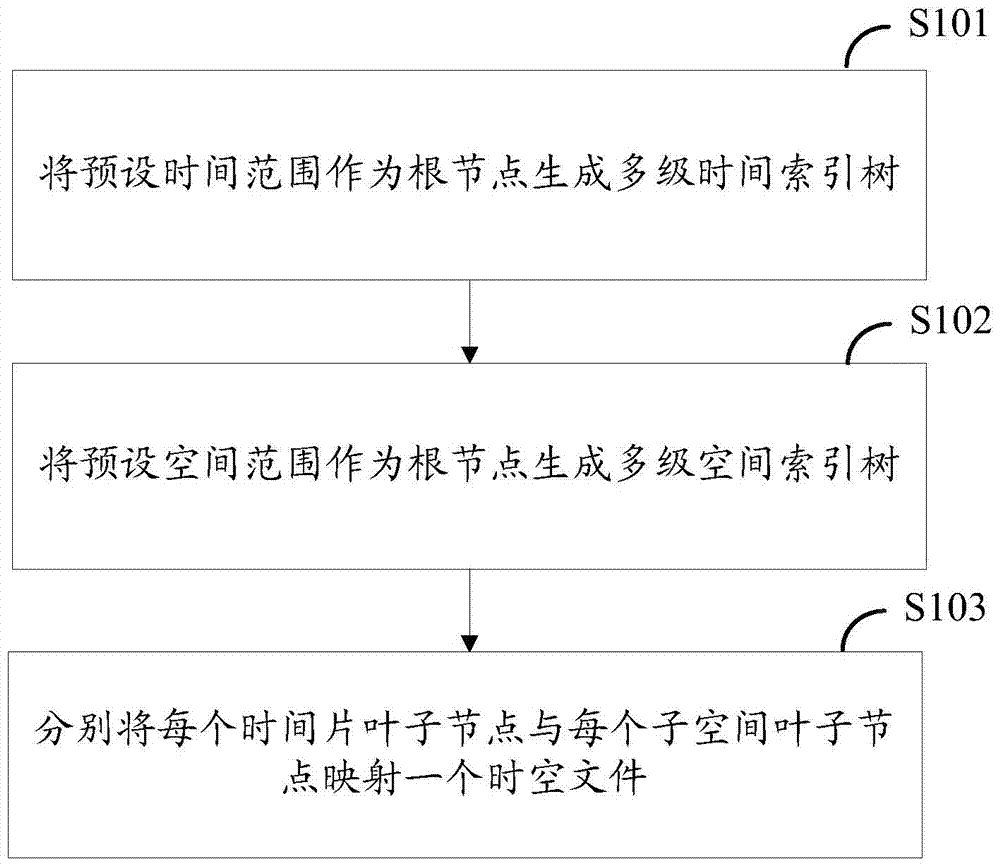Spatio-temporal data index building and searching methods, a spatio-temporal data index building and searching device and spatio-temporal data index building and searching equipment
A technology for creating spatiotemporal data and indexes, which is applied in the computer field and can solve problems such as low efficiency when searching spatiotemporal data
- Summary
- Abstract
- Description
- Claims
- Application Information
AI Technical Summary
Problems solved by technology
Method used
Image
Examples
Embodiment 1
[0073] In Embodiment 1 of the present invention, a method for establishing an index of spatio-temporal data is provided, such as image 3 As shown, it specifically includes the following steps:
[0074] S301. Generate a multi-level time index tree by using a preset time range as a root node; wherein, the multi-level time index tree includes multiple time slice nodes, and the time slice nodes closer to the root node represent longer time slices.
[0075] In this step, the generated multi-level time index tree is composed of a root node, a time slice leaf node, and a time slice node between the root node and the time slice leaf node, where the root node represents the preset time range, and the time slice leaf The node represents the smallest time range that cannot be further divided. The time range represented by the time slice node between the root node and the time slice leaf node is less than the preset time range and greater than the time range represented by the time slice...
Embodiment 2
[0109] In Embodiment 2 of the present invention, a method for establishing an index of spatio-temporal data is provided, such as Figure 5 As shown, it specifically includes the following steps:
[0110] S501. Using the preset time range as the root node, the following method is used to generate a multi-level time index tree:
[0111] Divide the preset time range into a preset number of sub-time slices with the same length, and perform the following steps in a loop until the length of the currently obtained sub-time slice is equal to the length of the time slice represented by the leaf node of the time slice: Divide the currently obtained sub-time slice The time slice is used as a child node of the time slice node corresponding to the parent time slice of the sub-time slice; and the currently obtained sub-time slice is further divided into a preset number of sub-time slices with the same length; or
[0112] According to the distribution of the generated spatio-temporal data w...
Embodiment 3
[0126] In Embodiment 3 of the present invention, a spatio-temporal data query method based on the embodiment of the present invention is provided. The spatio-temporal data query method can be based on the spatio-temporal data index establishment method provided in the above embodiment, such as Figure 7 As shown, it specifically includes the following steps:
[0127] S701. Determine the time slice node corresponding to the time query condition in the multi-level time index tree, and the subspace node corresponding to the space query condition in the multi-level space index tree.
[0128] Further, in this step, the time query condition input by the user may correspond to any node in the multi-level time index tree, for example, the time query condition input by the user may correspond to the entire preset time range, or may correspond to one or more Time slice leaf nodes correspond.
[0129] Similarly, the spatial query condition entered by the user can correspond to any node ...
PUM
 Login to View More
Login to View More Abstract
Description
Claims
Application Information
 Login to View More
Login to View More - R&D
- Intellectual Property
- Life Sciences
- Materials
- Tech Scout
- Unparalleled Data Quality
- Higher Quality Content
- 60% Fewer Hallucinations
Browse by: Latest US Patents, China's latest patents, Technical Efficacy Thesaurus, Application Domain, Technology Topic, Popular Technical Reports.
© 2025 PatSnap. All rights reserved.Legal|Privacy policy|Modern Slavery Act Transparency Statement|Sitemap|About US| Contact US: help@patsnap.com



